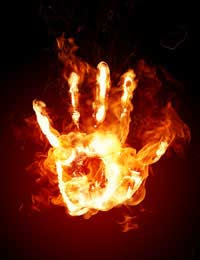LYRIC O’ THE DAY:
So pardon me while I burst into flames
I’ve had enough of the world and its people’s mindless games
So pardon me while I burn and rise above the flames
--Pardon me, Incubus
There are times when I feel like I am on fire, figuratively speaking. I’m focused, productive--a whirling dervish of epic organization and creativity.
And then there are the other 364 days of the year.
But I guess a figurative fire in your soul is better than a literal one, which brings me to the subject of today’s mythbusters. Spontaneous Human Combustion (SHC) is the burning of a living human body without obvious source of external ignition. In theory, some internal milieu creates an ideal environment for the subject to burst into flames. In the last 300 years, about 200 cases of the phenomenon have been reported. With over six billion people in the world, this makes human torchdom an uber-rare occurrence except in comic books.
There are a variety of explanations for the phenomenon, ranging from the paranormal to the physiological. Almost all cases involve people who are sedentary, either due to obesity or age, and most are in poor health or otherwise impaired by drugs or alcohol.
The earliest suggested case of SHC was in Italy in 1470 when Polonus Vorstius, a knight known to love his wine and women, supposedly quaffed a particularly wicked brandy one evening and then spewed forth flames and died. I had a similar reaction after drinking a concoction my bestie at the time made for me called The Three Wise Men. Jim, Jack and Johnnie were never meant to be mixed. (FYI, if you add Jaeger, it’s called The Four Horseman. And you should definitely prepare for the apocalypse if you’re still standing afterwards.)
The first scientific evaluation of Spontaneous Human Combustion came from Danish physician Thomas Bartholin in 1663. He described a woman in Paris who seemingly burned alive while sleeping--however, the straw mattress she slept upon remained intact. Fifty years later, Nicole Millet, the alcoholic wife of a wealthy French landlord, burned to death while seated in her chair in the family kitchen. After her death, Monsieur Millet was arrested for her murder. Using the defense of spontaneous human combustion, he was acquitted of all charges. Jonas Dupont, another Frenchman, was so inspired by this story that he published a collection of SHC cases in his “De Incendiis Corporis Humani Spontaneis” in 1763.
A famous U.S. case of human combustion involved a physician named John Irving Bentley. Bentley, a 92 year-old pipe smoker, was found in his bathroom by a meter reader--or at least the lower half of his right leg (slipper intact) and his walker were found. The charred hole that surrounded the doctor was approximately two feet square, but the remainder of the house was intact. Given the condition of the body, the coroner could only comment that death was likely due to asphyxiation and burning of the body, possibly with pipe tobacco as an ignition.
 |
| Forensic photo taken of the remains of Dr. Bentley |
Some religious zealots use cases such as these as a sign of the Big Guy laying down some heavenly smiting. Why an elderly man on his way to the loo deserved smiting remains unexplained, but in April 2011, a man supposedly burst into flames while watching videos in a San Francisco porn shop. I don't believe the case was divinely orchestrated, but is an impressive feat of friction to say the least.
The most researched case of SHC is that of St. Petersburg, Florida resident Mary Reeser in 1951. Mary was a portly woman who settled down in her armchair with a cocktail of sleeping pills, alcohol, and a cigarette one night, only to awaken a victim of SHC. When she was found, her skull had burned to the size of a baseball, but most of the chair, as well as the surrounding room, was unscathed (granted, her apartment was floored and walled with concrete). The FBI and some of the nation’s best forensic scientists were involved in her case.
Reeser’s case exemplifies the hypothesis of “the wick effect,” in which a small external flame--in this case, the cigarette--chars the clothing of the victim, eventually splitting the skin below. In a more rotund person that is impaired with mother’s little helpers, this slow burn may not be sensed. Fat is released from the wound, which is then absorbed by the clothing. And now you have a wick for a very human candle. Forensic scientist John DeHaan experimentally supported this theory using a dead pig wrapped in cloth.
 |
| Not part of DeHaan's experiment. Saliva is a poor fire extinguisher. |
The fire fueled by the pig's body fat released less than 80 kilowatts of heat--no more than a large waste basket fire. This explained why surrounding items often do not ignite and why there is usually lots of sooty, greasy residue left behind. Essentially a body becomes a large tallow candle under the right circumstances: impaired victim, ready amounts of fuel (i.e. copious corpulence), and some kind of ignition, be it cigarette, misguided ember, or electricity. For those of you partial to CSI, Grissom and his band of merry forensicists replicated DeHaan's experiment on an episode dealing with SHC.
If the wick effect doesn’t light your fire, there are still other explanations. Skeptics often believe that most of these incidents are actually murder coverups and an accelerant is just never identified. Others suggest that special circumstances in the victim combined with high energy particles or static electricity may serve as an ignition source. Alcoholic victims are thought to be more susceptible due to that tasty accelerant in their bloodstreams. That theory was supported by Charles Dickens when he used it to kill off his character Krook in the novel Bleak House. However, if the ignition of an alcohol requires a mix that is around 40% ethanol, but death via alcohol poisoning occurs at around 0.5% blood alcohol level, the likelihood of a human consuming enough alcohol to ignite is nil. Unless you’re Keith Richards.
 |
| Do not light that cigarette, Keith. |
Larry Arnold, a self-proclaimed SHC expert, suggested there is a subatomic particle called the pyroton that is responsible. This particle (whose existence has never been confirmed) interacts with human cells to create a mini-power generator and explosion. Sort of like nuclear fission on a cellular level. Other less explosive theories include spontaneous MASER (microwave amplification by stimulated emission of radiation) beams, which can occur in nature from decaying atoms and geomagnetism.
For all of you yoga lovers out there, the pyrokinetic powers of kundalini have also been implicated. Kundalini is described as a dormant energy within all humans, normally coiled at the base of the spine. It often is represented by a serpent. Through meditation and yoga, one can awaken the kundalini and make it rise until it reaches the top of the head, producing a powerful awakening in those who experience it. It is suggested that those who cannot channel this heat energy properly may find themselves injured.
Cobra pose at your own risk.
My favorite explanation for Spontaneous Human Combustion comes from that bastion of reliable scientific information, South Park.
Randy Marsh, father extraordinaire, explains SHC as a new lover’s phenomenon. Victims try to avoid passing gas in front of their new sweetheart, and in doing so create a methane bomb waiting to happen. This cartoon theory actually has a factual basis. Hydrogen and methane are flammable gases produced by bacteria in the gastrointestinal tract, mainly the large bowel. There are case reports of intraoperative explosions ignited from the combination of cautery, methane, and the high oxygen environment of the surgical suite.
The idea of bursting into flames due to flatulence should serve as a lesson to fraternity boys across the nation.
Have a wonderful week! I am looking forward to some days off after being on service for the past month so I can catch up with blogs and writing! I also need to post responses to some awesome blog awards I received last week, so stay tuned. Thanks Annalisa, Trisha, and Kathleen for thinking of me!























